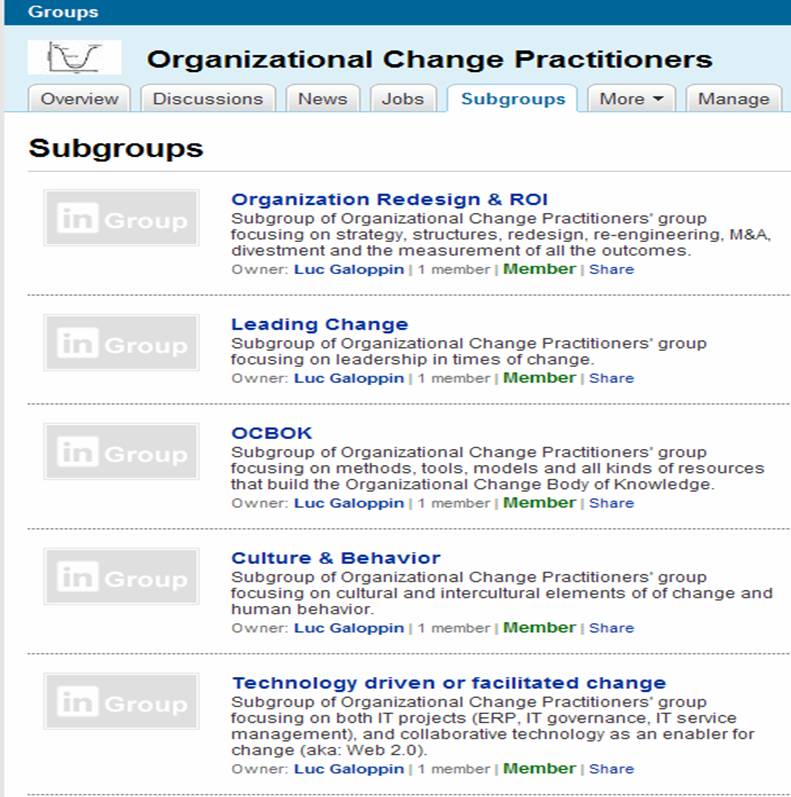Hello Organizational Change Practitioners,
This is to inform you that I have done my homework. A few weeks ago LinkedIn allowed us to create subgroups within this group. Subgroups are like a break-out session at a conference. They enable you to create more focused areas than in the main group.
I decided to create a maximum of FIVE subgroups. But before I would do so I asked to hear from you which ones you would recommend. I received about 90 answers, each containing on average 3 recommendations. I didn’t expect such a response!
As a next step I had to cluster. My intention was to create a poll on LinkedIn in order to select the final 5, but the polls running on LinkedIn only have maximum 5 entries. So I decided to have a second look … and there I was with the final 5! Please read on if you want to find out how I selected the final 5, and why I gave them their particular name.

PART I: CATEGORIES FOR SUBGROUPS => CLUSTERING
I obtained the below categories by shuffling, re-shuffling and re-shuffling the suggestions:
1. LEADING CHANGE
Communication
Consultants
Managers
Change Leadership
Leadership
Communication
Large Scale Change and the Individual
Leadership Support
leadership
Leadership/Sponsorship
Stakeholder Management
Communication
Building Capability
Leading teams through change
Leadership and organizational alignment
Busting silo barriers
vision, leadership & communication
leadership change
Stakeholders and sponsors
Leadership Alignment (strategy, ROI, performance issues)
Board/Exec team level interventions
2. ORGANIZATION REDESIGN
merger integration
divestment
Mergers and Acquisitions; Divestitures
mergers, downsizing, integration issues
Restructuring (merger, acquisition, re-engineering, downsizing, growth, globalisation, etc)
M&A driven change
Business Transformation
Organization Design
organization
Enterprise Architecture (touches IT, Culture, people, leadership, ROI)
Strategy driven (e.g., change in products or markets)
organisation design
Strategy
Structure
strategy,
Strategy-driven transformation
strategy
Re-engineering/ redesigning organizations (M&A, functional, performance)
Strategic Change (include M&A, Business Transformation Outsourcing)
Business Process Change
Corporate
Strategy driven transformation
Organisational Strategy
New organizations
Organization Development
change process itself
Organizational Maturity
Process
Dynamic Systems Alignment
process improvement
Alignment with HR Processes
process,
process
strategic change
3. ROI (Return On Investment)
ROI
value driven target operating model
ROI
performance management
Performance driven change
Capacity Development
Organizational Effectiveness
Performance Improvement (could include Six Sigma, Best Companies, Customer Insight, IIP, ERP, Balanced Scorecard, Training and Skills, Mentoring, etc)
Compliance driven change
4. OCBOK(Organizational Change Practitioners’ Body Of Knowledge)
Training
Methodology
Resources (Tools and Techniques)
methodology
Books, Articles, & Research Findings
Tools and mental models
Methodology
Methodology (culture, org alignment, training, communication, coordination with business process redesign)
tools – models, methodologies, and roadmaps, processes
Change management practice
books/articles related to change
Change Models (approaches, best practices, case studies, resources)
Models and Methodologies
Lean Six Sigma Change
Methods and Tools
5. HUMAN SIDE OF CHANGE
awareness
common denominator – human beings and change. What about the ‘human element’
human behavior
human behavior
behavioral change
TRANSFORMATIONAL
sustainability (‘what makes change stick’)
6. CULTURE
culture
Cultures/Strategy
Culture eats strategy for breakfast
Intercultural
Culture change
CULTURAL
context – international, large scale, health care, etc.
culture
culture change
workplace cultural change
Culture change
Culture (public, private, non-profit, small biz)
culture
culture
organizational culture
Organisational Culture (could include Attitude change, Team Building, Motivation, Gaining ‘Buy-In’, Coaching, Engagement, Staff Surveys, Management Styles, Leadership, National and Global cultural development. etc.
Non western contributions to change
7. IT RELATED CHANGE
system changes
IT Service Management
ERP
IT Service Management
changes in IT
IT Governance
ERP
Technology driven (e.g., ERP implementation)
systems
IT projects/new systems implementation
Technology (ERP, Web 2.0, emerging technologies)
Technology-Driven Change (ERP, Web 2.0)
Technology enabled change
systems implementation
technology
systems change
‘New Technologies’ – this could then evolve continuously as new opportunities develop with advances in technology
8. WEB 2.0
E-Culture (Web 2.0 and further)
Web 2.0
Web 2.0
E-Transformation
9. INDUSTRIES
Careers
Government
Research
Non Profit IT Governance
health care delivery change management
nonprofit
energy
transportation
manufacturing
public sector
retail
health care
communications
pharma
hi-tech
Customers
Market Segments: Government; Corporate; Research; Non Profit, Emerging (e.g., Web 2.0)
Health care
health care
HR
business
10. REGIONS
regional sub-groups
geography
PART II: REDUCING CLUSTERS TO MAXIMUM 5 SUBGROUPS
In order to select the final 5, I have broadened some categories up:
1. LEADING CHANGE
2. ORGANIZATION REDISIGN & ROI (Return On Investment)
3. OCBOK (Organizational Change Body Of Knowledge)
4. CULTURE & BEHAVIOR
5. TECHNOLOGY DRIVEN OR FACILITATED CHANGE
As for “industries” and “regions”, I have decided not to create them, as these are either tackled in other LinkedIn groups, or they run across our five subgroups.
PART III: WILL I APPOINT SUBGROUP MANAGERS?
I don’t know yet… let’s first see if we can make this work!
Good luck to our community and thanks again for contributing!
Luc Galoppin
PS: Not yet a member? Join us right now!
Related Articles:
Web 2.0 includes Invisible Hand – June 29th, 2009

